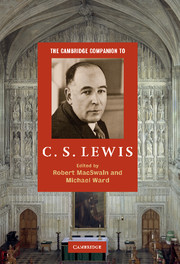19 - The Chronicles of Narnia
from Part III - Writer
Published online by Cambridge University Press: 28 November 2010
Summary
C.S. Lewis was a lifelong reader of fairy tales and children's stories, though his repertoire was limited and he returned repeatedly to his roster of favourites: George MacDonald, Kenneth Grahame, Beatrix Potter, E. Nesbit. As a middle-aged man he wrote, 'When I was ten, I read fairy stories in secret and would have been ashamed if I had been found doing so. Now that I am fifty I read them openly. When I became a man I put away childish things, including the fear of childishness and the desire to be very grown up.' So shameless was he in this matter that, in a scholarly lecture, he used Beatrix Potter to illustrate the theme of disobedience in Paradise Lost ('It is, after all, the commonest of themes; even Peter Rabbit came to grief because he would go into Mr. McGregor's garden'); and in a learned discourse on friendship he invoked not just Aristotle but also The Wind in the Willows ('the quaternion of Mole, Rat, Badger and Toad suggests the amazing heterogeneity possible between those who are bound by Affection'). That he would choose to write children's books of his own, however, has surprised some. He was a bachelor for most of his life and had no children of his own, nor did those closest to him discern any particular affection for or interest in children.
- Type
- Chapter
- Information
- The Cambridge Companion to C. S. Lewis , pp. 265 - 280Publisher: Cambridge University PressPrint publication year: 2010
- 1
- Cited by



